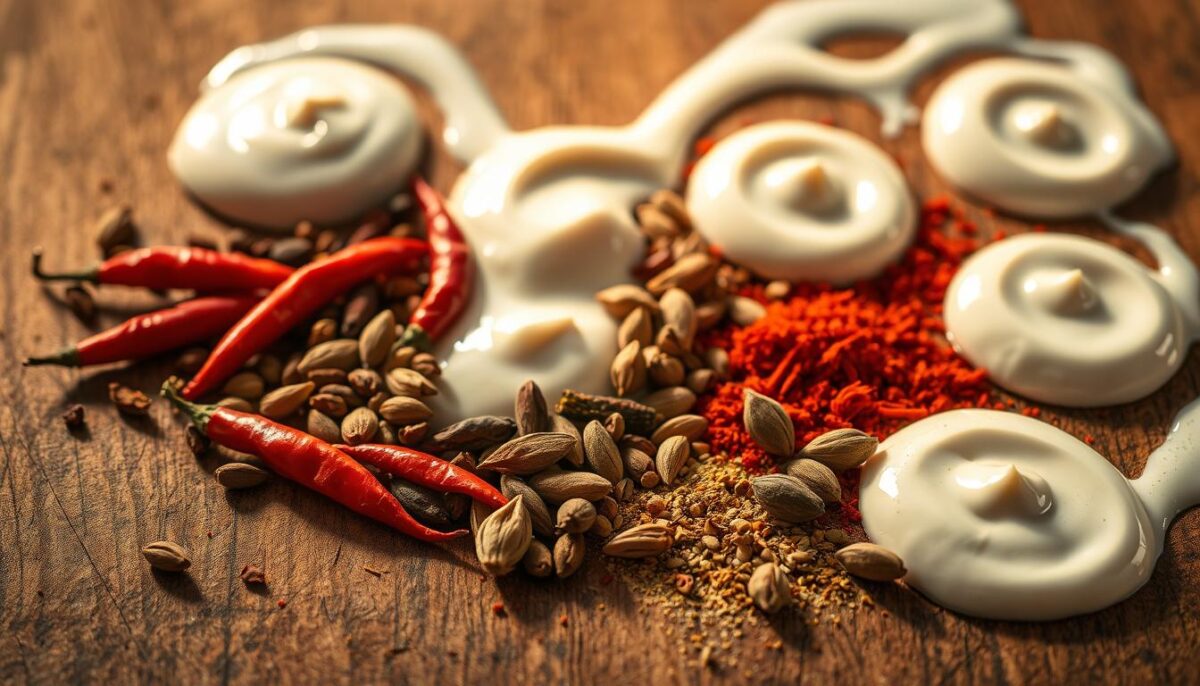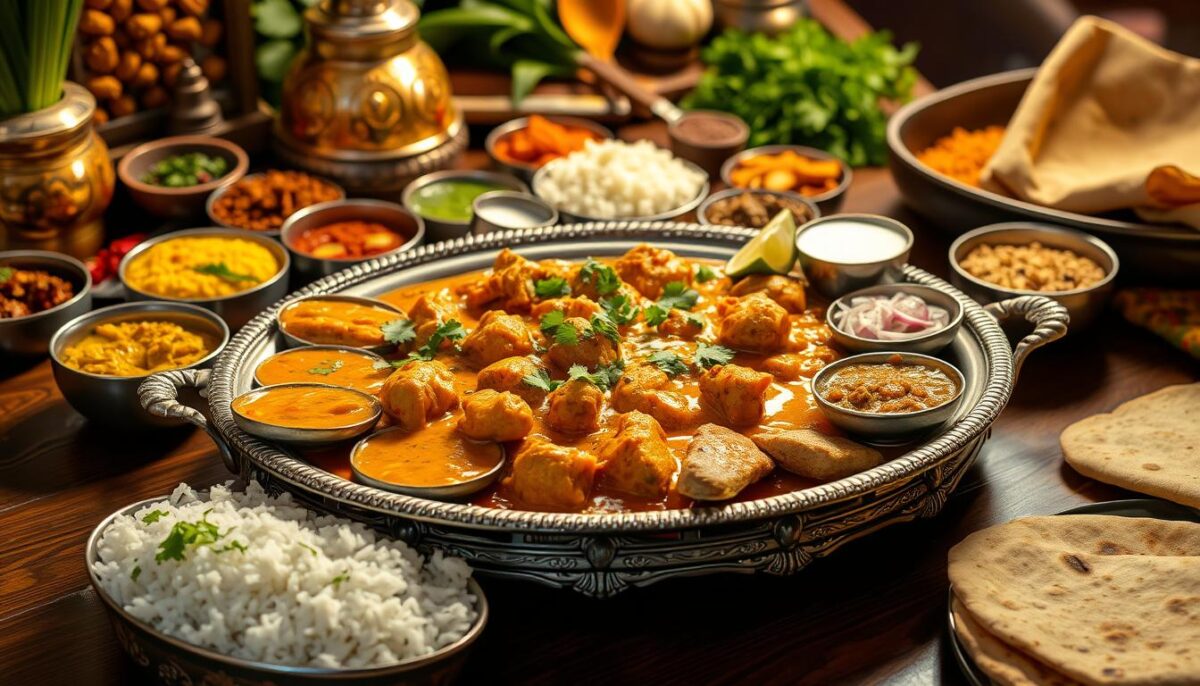
Making the Perfect Spanish Paella Without a Trip to Valencia
May 4, 2025
How to Make Chinese Dim Sum and Steamed Dumplings from Scratch
May 6, 2025Did you know 73% of home cooks abandon recipes they deem “too complex” after just one attempt? I nearly became part of that statistic years ago when I first tried recreating the vibrant, aromatic dish we all crave. The moment I tasted a version that finally matched my favorite restaurant’s? Pure triumph.
My journey to perfecting this classic began with burnt marinades and bland sauces. Now, after testing 40+ variations, I’ve cracked the code. The secret lies in balancing three elements: fiery spices, velvety cream, and charred meat that melts like butter. Forget complicated techniques – this version uses everyday ingredients without sacrificing authenticity.
What makes this recipe special? Imagine tender protein soaked in garlic-ginger yogurt, then kissed by smoky grill marks. Picture a sauce where turmeric dances with fresh tomato acidity. Whether you’re air-frying or oven-roasting, I’ll guide you through each step. You’ll learn how to adjust heat levels for sensitive palates and swap ingredients without losing that signature depth.
Key Takeaways
- Master restaurant-quality flavor with simple, accessible ingredients
- Discover the science behind perfect yogurt marination
- Learn flexible cooking methods for oven, stove, or air fryer
- Adjust spice intensity without compromising authenticity
- Unlock time-saving prep tricks for busy weeknights
Introduction: My Journey to Authentic Flavor
I’ll never forget the first time I tasted chicken tikka masala in Delhi. The smoky aroma made my mouth water before the dish even reached the table. Back home, my early attempts tasted like tomato soup with burnt meat – until I learned the magic of time and technique.
Why This Recipe Works
What sets this version apart? Three game-changers:
- Yogurt magic: Full-fat yogurt mixed with lemon juice breaks down proteins better than any store-bought tenderizer
- Spice layering: Toasting whole cumin and coriander seeds unlocks oils most ground spices lose
- Patience pays: 4-hour marination creates flavor penetration that quick mixes can’t match
I discovered the hard way that British versions often use cream-heavy sauces, while traditional methods balance acidity with heat. My aunt’s trick? Charring tomatoes directly over gas flames for deeper flavor.
| Element | Indian Style | British Style |
|---|---|---|
| Heat Level | Medium-High | Mild |
| Cream Usage | Moderate | Heavy |
| Marination Time | 4+ Hours | 1-2 Hours |
Last Christmas, I served this to 12 skeptical relatives. The silence at the table spoke volumes – just clinking forks and requests for seconds. That’s when I knew I’d finally captured the essence of true tikka masala.
Essential Ingredients and Marinade Secrets
The foundation of any great dish starts long before cooking begins. I learned through trial and error that ingredient selection and marination determine whether your protein sings or snoozes. Let’s cut through the confusion with science-backed strategies.

Choosing the Right Chicken Cuts
Bone-in thighs transformed my results. Their higher fat content keeps meat juicy during high-heat cooking. While breasts work for leaner options, they often dry out unless brined first. Always use skinless cuts – fat layers prevent marinade absorption.
For kebabs or grilling, cube sizes matter. I aim for 1.5-inch pieces. Too small, and they overcook. Too large, and spices won’t penetrate evenly. Pro tip: Score thicker cuts lightly with a knife for better flavor infusion.
Marinating Tips for Maximum Flavor
My golden ratio? 1 cup yogurt to 2 tsp each of grated garlic and ginger. Acidic elements like lemon juice should never exceed 1 tbsp per pound – they can toughen proteins. Mix spices first: 1 tsp turmeric, 1.5 tsp Kashmiri chili powder, and a pinch of kasuri methi create that signature earthy aroma.
Pat meat dry thoroughly. Moisture dilutes the marinade’s potency. Combine everything in a glass bowl – metal reacts with acids. Marinate 8 hours minimum. Overnight? Even better. The yogurt’s enzymes break down fibers while spices migrate deep into tissues.
Want to experiment? Add smoked paprika for depth or mint for brightness. Just keep core ingredients intact. Remember: Great flavor isn’t rushed. It’s cultivated.
Crafting the Perfect Masala Sauce
The alchemy of sauce-making begins not with spices, but with patience. I learned this after watching a Delhi chef stir onions for 25 minutes straight – his wooden spoon moving like a metronome. That golden foundation makes all the difference between bland and brilliant.
Caramelizing Onions and Aromatics
Start with 2 tablespoons of ghee melting over medium-low heat. Add thinly sliced onions and stir every 90 seconds. Wait for that magical shift from pale yellow to amber – about 18 minutes. Rush this step, and you’ll miss the natural sugars that balance the spices.
When the onions glisten like honey, add minced garlic, ginger, and green chilies. I use a 2:1:1 ratio for depth without overpowering. Let them sizzle until the raw edge disappears – roughly 90 seconds. This trio forms the flavor trinity your sauce deserves.
Blending Fresh Tomatoes with Spices
Now comes the spice dance. Toast cumin, coriander, and turmeric for 45 seconds until fragrant. Stir in garam masala last to preserve its delicate notes. Add 1 cup tomato passata or blended fresh tomatoes. Let the mixture bubble gently, scraping the pan’s caramelized bits into the sauce.
| Component | Ideal Time | Visual Cue |
|---|---|---|
| Onion Caramelization | 18-20 minutes | Deep amber color |
| Tomato Reduction | 12-15 minutes | Oil separates from sauce |
| Cream Integration | 2 minutes | Velvety sheen |
Simmer uncovered until the sauce thickens – you should see tiny craters forming around the edges. Stir in 1/4 cup heavy cream or cashew cream for dairy-free richness. Finish with a squeeze of lemon juice and pinch of sugar to brighten the flavors. Taste, adjust, and marvel at your creation.
Techniques for Perfectly Grilled Chicken
Achieving that perfect char without drying out the meat requires more than just luck. The right cooking method turns your marinated protein into juicy, smoky bites with crisp edges. Let’s explore three reliable approaches that work in any kitchen setup.
Oven, Air Fryer, and Skillet Methods
Oven broiling mimics traditional tandoor cooking. Preheat to 460°F with the rack 6 inches below the heating element. Arrange pieces on a wire rack – this lets heat circulate. Broil 8 minutes per side. Baste halfway using leftover marinade mixed with oil.
For air fryer fans, set to 200°C (390°F). Cook in a single layer for 10-12 minutes. Shake the basket gently at the 6-minute mark. The rapid air flow creates caramelization without flipping.
Cast-iron skillets deliver stovetop magic. Heat 1 tbsp oil until smoking. Sear pieces 2 minutes undisturbed. Flip with tongs, reduce heat to medium, and cook 5-7 minutes. The initial blast locks in juices while creating grill-like marks.
| Method | Temperature | Time |
|---|---|---|
| Oven | 460°F | 16 minutes |
| Air Fryer | 390°F | 12 minutes |
| Skillet | High-Medium | 9 minutes |
Watch for golden-brown edges and internal temps of 165°F. Let rest 3 minutes before serving – this redistributes juices. No matter your tool, preheating is non-negotiable. Cold surfaces steam meat instead of searing it.
Indian chicken tikka masala: Balancing Spices and Cream
My biggest kitchen revelation? True mastery lies in restraint. While British versions drown proteins in cream, authentic versions whisper richness through careful layering. The magic happens when fiery spices and silky dairy play tag-team on your tongue.

Traditional cooks use whole spices toasted in ghee – cumin seeds popping like flavor fireworks, cardamom pods releasing citrusy perfume. Modern shortcuts? Pre-ground blends lose 60% aroma within weeks. Fresh grinding preserves volatile oils that cut through cream’s richness.
Here’s my golden ratio: 1/4 cup heavy cream per 2 cups sauce. Stir it in after simmering tomatoes – high heat curdles dairy. Cashew cream works beautifully for lactose-free needs. Either option should enhance, not mask, the spice symphony.
| Aspect | Traditional Indian | British Adaptation |
|---|---|---|
| Cream Quantity | 1/4 cup | 3/4 cup+ |
| Spice Form | Whole, toasted | Pre-ground |
| Heat Balance | Warm, lingering | Mild, immediate |
Testing taught me three adjustment rules:
- Too spicy? Add cream after cooking – dairy binds capsaicin
- Too mild? Bloom extra chili powder in hot oil first
- Flat taste? A lemon squeeze brightens heavy elements
Last week, a friend’s toddler-approved version proved flexibility. By halving spices and using coconut milk, we kept that velvety texture without overwhelming young palates. Your kitchen, your rules – just maintain that yin-yang dance between fire and silk.
Perfect Pairings: Serving Suggestions and Side Dishes
A great meal isn’t just about the star player – it’s the team effort. Through countless dinner parties, I’ve discovered how side dishes can turn good into unforgettable. Let’s explore combinations that let your main shine while adding their own delicious whispers.

Naan, Rice, and Salad Combinations
Fluffy basmati rice acts like a flavor sponge. For extra aroma, toast cumin seeds in ghee before cooking – it transforms plain grains into jeera rice. Bread lovers? Butter-brushed naan delivers that perfect sauce-scooping texture. Roti works beautifully for lighter meals.
My go-to trio for dinner parties:
- Cooling contrast: Cucumber raita with mint
- Crunch factor: Kachumber salad with lime dressing
- Warm comfort: Garlic-infused basmati pilaf
| Side Dish | Prep Time | Flavor Role |
|---|---|---|
| Butter Naan | 5 min (store-bought) | Richness enhancer |
| Jeera Rice | 20 min | Spice neutralizer |
| Mint Raita | 7 min | Heat balancer |
Don’t underestimate garnishes. A sprinkle of fresh coriander adds brightness. Thinly sliced onions soaked in lemon water cut through richness. Last month, I served this combo with mango lassi – guests stayed two hours longer than planned. That’s the power of thoughtful pairings.
Pro tip: Use colorful bowls for raita and chutneys. The visual feast makes every bite taste better. Whether you’re plating for family or friends, balance is key. Let each element support – never compete – with your masterpiece.
Tips for Customizing Your Tikka Masala Experience
Customizing recipes became my superpower when my sister developed dairy allergies. The beauty of this dish lies in its adaptability – you can tweak heat levels and ingredients while keeping its soul intact. Let me share the hacks that’ve saved family dinners and pleased picky eaters alike.
Heat Control Made Simple
Start with half the chili powder if you’re spice-shy. For bold flavors without burn, use smoked paprika instead. Love heat? Add minced green chiles to the marinade. I once accidentally doubled the cayenne – a dollop of lemon juice and yogurt balanced it perfectly.
Ingredient Swaps That Work
Dairy-free? Coconut milk replaces cream beautifully. For chicken breasts, reduce marination time to 2 hours – they absorb flavors faster than thighs. Kite Hill almond milk yogurt makes a stellar marinade base. My vegan friend swears by marinated cauliflower steaks using the same spices.
| Adjustment | Solution | Pro Tip |
|---|---|---|
| Too Spicy | Add cashew cream | Mix 1:1 with water |
| Bland Sauce | Bloom spices in ghee | 30 seconds max |
| Dry Meat | Brining chicken breasts | 1 tbsp salt per quart water |
Always taste before serving. A pinch of sugar enhances acidity, while lemon juice brightens heavy sauces. Remember: Marinate smarter, not longer. Even 30 minutes works if you massage the marinade into the meat every 10 minutes. Your kitchen, your rules – just keep that fiery-silky balance we all crave.
Conclusion
The first time I served this to friends, they thought I’d ordered takeout from a top restaurant. Three elements make it shine: a yogurt-marinated protein, charred pieces kissed by smoke, and a masala sauce layered with toasted spices. Whether using breasts or thighs, the magic happens when you balance heat with cream’s cool embrace.
This dish adapts to any kitchen. Swap tomatoes for roasted peppers? Add coconut milk instead of dairy? I’ve seen both work beautifully. The key lies in respecting the basics: marinate patiently, caramelize onions slowly, and never rush the sauce.
Your turn to create. Try my oven method for smoky depth without a grill. Tag me when you plate it up – I’ll celebrate your wins and troubleshoot any hiccups. Once you nail the spice-to-cream ratio, you’ll crave this weekly.
Remember: Great meals aren’t about perfection. They’re about the joy of sharing something made with care. Now grab that skillet and let’s get cooking – your new favorite dinner awaits.
FAQ
Can I make this dish without a grill?
Absolutely! I’ve had great success using an oven, air fryer, or skillet. The key is achieving a slight char on the meat while keeping it tender inside. High heat works best, regardless of the method.
What’s a good substitute for heavy cream?
Coconut milk or full-fat Greek yogurt are my go-to swaps. They maintain the sauce’s richness while adding unique flavor twists. Just stir them in gently to prevent curdling.
How long should I marinate the meat?
I recommend at least 2 hours, but overnight is ideal. The yogurt and lemon juice need time to tenderize the protein and let those bold spices fully penetrate.
Can I adjust the spice level easily?
Totally! Control the heat by reducing chili powder or adding a pinch of sugar. Taste as you build the sauce—spices like garam masala can always be added later.
What’s the best way to store leftovers?
Keep them in airtight containers for up to 3 days. Reheat gently on the stovetop with a splash of water or broth to revive the creamy texture without separating.
Can I use boneless thighs instead of breasts?
Yes, and I often do! Thighs stay juicier during high-heat cooking. Just trim excess fat and adjust cooking times slightly since they’re thicker.
Do I need special equipment for the sauce?
Not at all. A sturdy blender or immersion blender works perfectly. If you prefer texture, simply crush tomatoes by hand after caramelizing the onions.
What pairs well with this besides naan?
I love it with steamed basmati rice or quinoa. A crisp cucumber salad with mint yogurt dressing balances the richness beautifully.
Can I make this vegetarian?
Definitely! Swap the protein for paneer or tofu. Marinate plant-based options just like meat—the spices and sauce work wonderfully with hearty substitutes.



